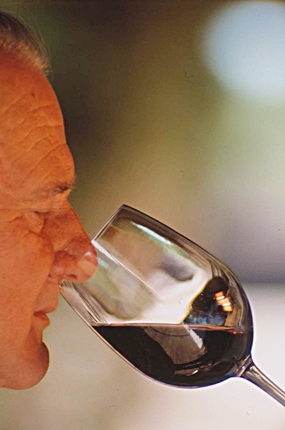Right then, here’s today’s Quiz Question. Which three countries are the world’s largest wine producers? If you answer “Italy, France and Spain”, then you’re absolutely right. Well done.
Collect your prize money at the door on the way out. But you know; the odd thing is that we see surprisingly few Italian and Spanish wines around here. Browsing in the local supermarkets, you’d be forgiven for thinking that the only wine-producing countries in the world are France, Australia and Chile.
 Owner Hugo Casanova – a nose at work.
Owner Hugo Casanova – a nose at work.
I’ve come across several excellent Chilean wines locally that really seem to reflect the characteristics of the grape. Here are two super bargain-basement wines from Chile, imported by those nice people at Wine Dee Dee in Bangkok.
Purisima “Classic” Cabernet Sauvignon 2011 (red) Chile (Bt. 299 @ Foodland)
At the end of the 19th century, the first members of the Casanova Family arrived in Chile from Italy, with the intention of producing wine in their new homeland. And produce wine they did, for over the years they achieved an enviable reputation. Today the Hugo Casanova Winery has an annual production of over a million litres and a storage capacity of two million. The company makes a wide range of excellent wines under the Casanova label and the Purisima range are their entry-level range. I’ve tasted several Purisima wines and I’ve always been impressed by their “true to the grape” character.
This wine is a very deep red and has an attractive oily appearance. There’s a typical Cabernet Sauvignon aroma of dark fruit, mint and herbs. A dash of spice, too. The fruit comes forward well on the palate and as you might expect, the wine is very dry.
There’s a good layer of satisfying tannin there too, which comes as a pleasant surprise. Now it shouldn’t be a surprise at all, because Cabernet Sauvignon is a grape known for imparting a layer of tannin to the wine. But honestly, during the last few weeks I have tasted so many Australian and Californian Cabernets that taste as though every last bit of tannin has been squeezed out of them. Now it’s all very well to cater for the mass market, but when you start taking away the very essence of the grape variety just to sell truckloads of insipid Cabernet that’s going a bit far, if you ask me.
Anyway, the point is that this Chilean wine really tastes like a Cabernet Sauvignon. It’s almost French in style; firm and slightly reserved, yet supple and fruity. You’ll need to give it a bit of time to open up. I found that having left it to rest in the decanter for half an hour, the texture became much softer and the lovely dark fruit aromas emerged.
Purisima “Classic” Sauvignon Blanc 2011 (white) Chile (Bt. 299 @ Foodland)
I was impressed by the lovely floral aroma of this pale straw-coloured wine. It has a spring-like grassiness too and reminded me of white flowers. Now I have to admit that unlike my other, I’m not much good with the names of flowers. She could spot a campanula trachelium at a hundred yards. I can recognise a daffodil or a rose, but that’s about it.
There’s quite a bite on the palate, and a good dollop of refreshing citrusy acidity. Sauvignon Blanc as you might recall, is a grape known for its assertive qualities.
But wait; don’t let me put you off. This is a Chilean Sauvignon Blanc and although rather less demanding than some of its French cousins from the Loire Valley retains the real Sauvignon character. Even though the wine is as dry as they come, there’s a pleasing softness on the palate. It has plenty of fruit up front, a refreshing citrusy tang and a long, dry and satisfying finish.
As I was doing the tasting, it occurred to me that this attractive wine would make the perfect partner for cod or dory fillets in batter or breadcrumbs, because the sharpness of wine would make a good contrast. And incidentally, I have found that you can make a superb fish batter by using those packets of Tempura flour. But this is the important bit; don’t add water as they tell you on the packet. Add beer instead, with a generous dash of white pepper, chili powder and paprika powder. Oh, and by the way, this is my secret recipe, so please keep it to yourself.




